Robert Heinlein - Chronological Order from Oldest to Newest
Favorites in Blue Text
John Wayne - Favorites in blue text
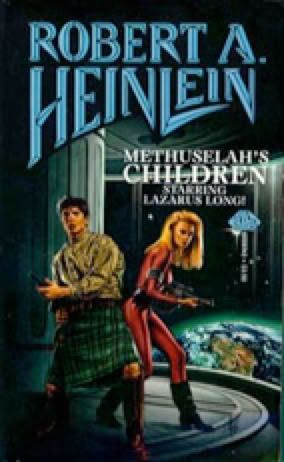
Methuselah's Children by Robert Heinlein (1941)
This novel is about the Howard Families; the product of a centuries-long eugenics scheme started in the late 19th century by a millionaire who died young, that encouraged intermarriage between particularly long-lived families. Several centuries later, a stable and peaceful world discovers the Howards, and demands the secrets of their extended life spans, refusing to believe that the Howard Families simply chose their ancestors wisely. This is the first appearance of Lazarus Long, who is so old that when he miscalculates his age he's off by a whole century. Although Lazarus is one of the Howards, his longevity appears to be from a spontaneous mutation, as he derives from only the second generation of the eugenic scheme. However, he appears to be naturally longer-lived than any of the other Howards. This book also has an appearance by the mathematical genius Andrew "Slipstick" Libby, previously seen as a teenager in the short story " Misfit". Hounded from the Earth, the Howards hijack a star ship meant for colonization and try to find a better planet to live on. They even find a planet where aliens live. When Mary Sperling joins the natives, Lazarus decides it's time to go back to Earth and claim their rights.

Beyond This Horizon by Robert Heinlein (1942)
The novel depicts a world where genetic selection for increased health, longevity and intelligence has become so widespread that the unmodified 'control normals' are a coddled, almost endangered minority. The control normals are preserved to maintain a backup of human stock in case the gene selection takes a wrong choice somewhere. The world has become an economic utopia; the "economic dividend" is so high that work has become optional -- a sort of welfare state for the upper middle class. The chief economic problem is in finding a way to use up the economic surplus: much goes into scientific research, but this has the side-effect of further increasing productivity a decade or three later, so long-term projects with no possible economic return are favoured (e.g. galactic astronomy). But there's trouble: dissatisfied elements are fomenting revolution, and it's up to gun-totin' Hamilton Felix to stop them. Guns and duels are permitted (An armed society is a polite society.), except for the control normals, whose reflexes are so poor compared to current human stock that they'd be slaughtered in combat

Rocket Ship Galileo by Robert Heinlein (1947)
Three teenagers in a rocket club are guided by a scientist to build an atomic-powered rocket that will take them to the moon.

Space Cadet by Robert Heinlein (1948)
This novel is about youngsters who join the patrol that keeps the peace in the solar system. From the space academy with a blind (but not unseeing) commandant to lessons in using a powered space suit; from discussions on ethics and responsibility to lessons in math and foreign cultures, this is a very believable schoolboy tale. Some of the issues include behavior in military and paramilitary organizations, and ethical issues common in young men. Matt and his friends avert possible war with the Venerians with some deft cultural maneuvering when a former schoolmate provokes the otherwise peace-loving matriarchical society of Venus.

Red Planet (1949)
When an unscrupulous headmaster seeks to prevent the annual migration of families to save the Company money, two boys run away from school to warn their parents. In a foreshadowing of many revolutions against bad authority, an uprising against the company forces retakes the school and effects the needed migration. The crusty Doctor MacRae and the two boys are heroes, but the relationship between one bouncer (kept as a pet) and the boy who "owns" him is the real key to this book. Absent that friendship, the Martians would have exterminated all the human colonists.

Sixth Column by Robert Heinlein (1941)
The mountain lab is a scene of turmoil as the novel begins. All but 6 personnel died suddenly, due to mysterious forces in the magneto-gravitic or electro-gravitic spectra. The scientists at the lab soon learn that they can selectively kill people, by releasing the internal pressure of their cell membranes. They discover other awesome forces, yet their challenge is: how can a handful of men throw off an invasion force, when all their communications have been severed and it is a crime to print a word in English? Noting that the invaders have allowed the free practice of religion, the Americans set up a false church of the Lord Mota in order to build up a resistance which Major Ardmore, the protagonist of the book, refers to as as the Sixth Column. Also reprinted as The Day After Tomorrow.

Farmer in the Sky (1950 )
Farmer in the Sky is a 1950 science fiction novel by Robert Heinlein about a boy who emigrates to Jupiter 's moon Ganymede, which is in the process of being terraformed , and who creates a farm out of gravel. In a future Earth where food is carefully rationed and Boy Scouts fly helicopters , a widower takes his son and new bride off-planet. After displaying heroics on the space ship, the boy is humiliatingly cut down to size by Scouts on his new home and struggles for acceptance. He volunteers to do the work of homesteading by himself, after his stepsister proves unable to live on the farm for health reasons.

The Puppet Masters (1951)
The narrator, an agent of a super-secret defense intelligence group referred to only as "The Section", wakes up to the jarring alarm of his skull phone. "Sam" - he later tells us his real name is Elihu Nivens, although that may not be true - is ordered to report to his agency's head. The director is known for most of the book as "the Old Man". We are later told that he is in fact Sam's father, and is that his name is Andrew Nivens, although again, that may not be true either. Sam is required to meet with the Old Man personally, for the emergency is that a space ship his landed in Grinnell, Iowa . The Section sent in several agents, but none came back; and they only got one fragmentary report: "They are little creatures, about --" (before the sound cut off). The Old Man risks the entire Section by going out in the field himself, along with "Mary", a female agent Sam hadn't met before. He tells Sam and Mary to put on a brother and sister act; he plays the slower of two not-too-bright country bumpkins out seeing the sights with an elderly relative. They encounter vaguely round-shouldered people, and Mary notices that the men aren't sexually attracted to her, which means that these men are obviously hag-ridden by parisitic slugs! The invaders have taken over their brains and nervous systems and control earthlings like a puppet master controlling a marionette!! Sam and the Old Man try vainly to convince the President of the United States about the menace but are dismissed. "Don't worry, the republic won't fall apart." So Sam forces his way into a TV executive's office intending to capture a parasite on live video (the author imagined many innovative futuristic gadgets for the story, but the portable VCR was not one of them) but a blown tube ruins the shot, and the President tells the Old Man to fire Sam. Sam heads off to his vacation cottage in New Hampshire with Mary: realizing their time may be very short, the agents decide to get married. Meanwhile, the invaders are multiplying, and no one will believe it. Apparently licked, the Old Man flies to Florida to lie on the beach and wait for the world to go to hell. But, wait! Sam has an idea .

Between Planets (1951)
The novel is the story of a young Earthling named Don Harvey who leaves his ranch school on Earth to be with his scientist parents on Mars . He gets caught up in the Venusian war of independence when his ship is captured by Venusian colonials. He is nearly blown up with the captured ship, but released at a space station because of his determination to go to Mars. This novel marks Heinlein's first benign depiction of extraterrestrials. A Venusian dragon by the name of Sir Isaac Newton befriends Don on board the ship from the space station to Venus. He turns out to be a genius physicist collaborating with Don's parents on advanced scientific principles that the colonials use to win the war with the government on Earth.

The Rolling Stones (1952 )
This is a story about a family of "Loonies" (i.e., Lunar citizens with a sense of humor) who buy a used spaceship and go sightseeing around the solar system. The twin teenaged boys, Castor and Pollux, buy used bicycles and hope to sell their cargo at a profit. Their sister sings on their radio show in the asteroids. Their kid brother Buster has the highest IQ of the whole family, and no one but granny Hazel can keep him in line. A Martian flat cat named Fuzzy Britches, born pregnant and producing a soothing vibration (compare tribbles ), makes more trouble and more money than anyone thought possible. Then Buster and Hazel get lost in the Asteroid Belt, and Hazel almost dies before they are rescued by the twins.
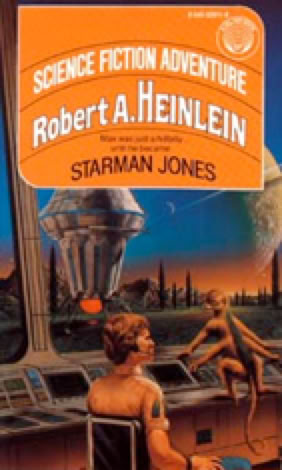
Starman Jones (1953)
After his father dies and his stepmother remarries, Max Jones runs away from the family farm. Following the ring road to a hobo camp, he finds a friendly face in Sam Anderson, a former Imperial Marine. Most occupations are controlled by guilds, and many are only open to hereditary membership. One of these is the Astrogator's Guild, and his uncle had been a member. Max hopes that before he died, his uncle had nominated him for hereditary membership, since his uncle had no children. He makes his way to Earthport in the hopes of becoming a starship astrogator, hitching a ride with a friendly trucker. Once there he is disappointed to find that his uncle never nominated him, but that his uncle's astrogation books could be returned to the guild for a refund of the large deposit his uncle had made to obtain them. (The friendly trucker who gives rides to down-and-out hitchhikers is a recurring theme in Heinlein's books.) With the money from his books, Max and Sam (who had stolen the books and tried to turn them in first!) get together and scheme to join the crew of a starship. Sam becomes a master-at-arms, and Max becomes a steward's mate third class (drawing on his hasty memorization of a borrowed book) after having his appearance aged somewhat by a cold-fingered matron in the back of a bar where beautiful young ladies serve colored water. On board the starship, Max is assigned by accident to work he understands: cleaning up after animals on the bottom deck, including feeding passengers' pets. Eldreth Coburn, owner of a spider monkey Max had befriended, discovers that Max can play 3-D chess and challenges him to a game (she lets him win, but we don't discover that until much later). Impressed with his ability, and perhaps somewhat romantically interested in him, she arranges for him to get a promotion to the ship's control room, where under the stern tutelage of Chief Astrogator Hendricks and the warmer but equally tough training of computerman Kelly, he becomes an Assistant Astrogator. In a confrontation with Hendricks, Max sheepishly admits to faking his record to get into space and is told off (but, to his surprise, not exposed or punished) by Hendricks. "It's worse than wrong, it's undignified!" When the aging captain sides with assistant astrogator Simes against Max (who found an error in the programming) and the ship turns up in uncharted space, the ship must land on a nearby planet. Admittedly lost, the ship is all but decommissioned and most of the crew help the passengers colonize their lovely new planet. But watch out for the centaurs and their throwing ropes.

The Star Beast (1954 )
John Thomas Stuart, one of whose ancestors brought "Cuddlepup" home from an interstellar voyage, has a problem. The pet he inherited has grown to gargantuan proportions; it ate a used Buick and (still worse) destroyed a neighbor's flowers. His mother wants him to get rid of it, and a court orders it destroyed. Johnny's only alternative is to sell his pet to a museum (which would study it to death, if they didn't dissect it immediately). So early one morning he runs away to the hills, riding on his talking pet's back. His girlfriend joins him and suggests bringing the beast back into town; they could hide it in a neighbor's greenhouse. The rest of the novel describes the discovery of the alien pet's true nature, and the diplomatic repercussions of this fact.
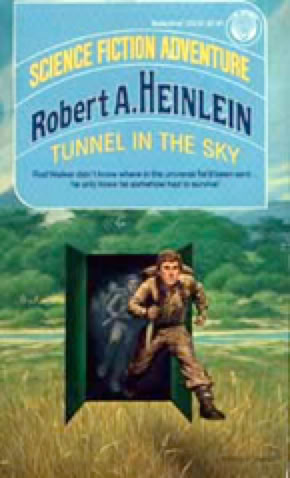
Tunnel in the Sky (1955 )
A Malthusian catastrophe has been averted only by the invention of the Ramsbotham Jump, used to teleport Earth's excess population to other solar systems. However, the capital and energy costs of operating the devices mean that extrasolar colonies are isolated until they can build up a sufficient trade surplus to pay for two-way communication. The book's theme is that social and moral structures are a response to economic and technological conditions; this is highlighted in the person of Rod Walker, an urbanite teenager with dreams of becoming a professional colonist. When his "solo survival" test goes wrong and he and a group of students are stranded on an unoccupied planet, it is only through luck that he survives his naïvete and becomes the seed for the establishment of a community. Heinlein tracks the political, social and technological development of this village of educated Westerners deprived of the rudiments of technological civilization, culminating in its immediate dissolution when contact with Earth is reestablished. Heinlein uses the discontinuity imposed by the Ramsbotham Jump to comment on the relativistic nature of morality and politics. Within minutes of arriving on the test planet, the murder of a fellow student for his gun demonstrates the irrepressible danger of human nature; likewise, the numerous political crises of the fledgling colony illustrate the need for legitimacy in a government appropriate for the society it administers. Even economics is revealed as adaptive to the situation; the extreme codependence of the colonists forces a comminutarian lifestyle with possessions being restricted to what can be carried on one's person. When the Earth technicians break through after several years of isolation, the culture shock experienced by the colonists evokes Heinlein's disquiet at modern civilization. Rod Walker, developed by necessity from an idealistic dreamer into the hard-headed leader of a sovereign state, is suddenly reverted to the status of a half-educated boy. It soon becomes apparent that emigration from Earth, far from a dream, is now the only way he can retain his identity. Further topics of the book are the value of human learning and ingenuity, the deceptive danger of weaponry, the necessity of ritual and entertainment to a cohesive society, the status of politics as an invention to permit cooperation in spite of human nature, and a derision of gender and racial roles beyond those necessitated by human biology. The book's rejection of unearned authority meshes with the libertarian character of Heinlein's early works, but its romanticisation of the pioneer ideal as the best means for human beings to reach self-expression presages that of Time Enough For Love.
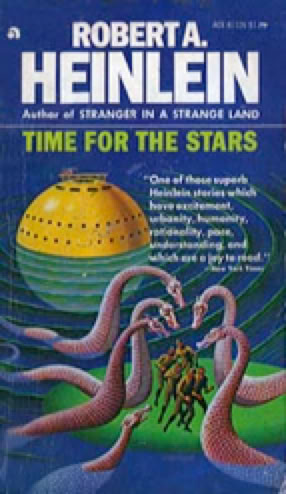
Time for the Stars (1956 )
In the novel, the Longrange Foundation is testing twins for telepathic ability, so they can help spaceships communicate over interstellar distances. Near-lightspeed travel is possible. Faster-than-lightspeed travel is not, but telepathy is apparently instantaneous, making it the only way for ships to communicate back to Earth when they arrive at star systems tens of light years away. A young man with a telepathic bond with his twin signs on as crew, leaving his twin behind on Earth to allow the ship to communicate. Also on the journey is his uncle (a military man). The trip is fraught with problems as trivial as an annoying roommate and as serious as mutiny.

Double Star (1956 )
The plot centers around a down-and-out actor. A brilliant mimic and pantomimist, Lawrence Smythe ("The Great Lorenzo") might have been another Charlie Chaplin had not his poisonous self-centeredness kept him socially isolated. Reduced to sleeping in a coin-operated cubicle, he is down to his last coin when a spaceman hires him to double for a public figure. It is only when he is reviewing the tapes for his impersonation that he realizes how deeply he was deceived. Lorenzo grows tremendously as a person during the story, for the person he is doubling for is none other than Joseph Bonforte, literally a "good and strong" political leader. When the role he assumes becomes permanent upon the death of Bonforte (who had been kidnapped and drugged into insensibility by political opponents), Smythe puts on more and more of Bonforte's persona. Finally, Penny (Bonforte's adoring secretary) says, "I never loved anyone else." Smythe has transformed from self-centeredness to nobility.

The Door into Summer (1957)
The novel opens in the year 1970. A mechanical engineer named Daniel Boone Davis has invented a robot capable of doing household chores and more, but his two-timing fiancée seduces his partner into gaining control of the company the three of them own. Bitter about his loss, he chooses "cold sleep" ( suspended animation ) with his pet cat, hoping to wake up thirty years later to a brighter future. What he finds upon revival makes him desperate to return to his past. Perhaps the book's greatest attraction to a 21st century reader is that the future it paints is of years already past. The novel alternates settings between 1970 and 2000/1, and Heinlein describes each setting with enough detail to make it interesting to see what he got almost right and what he missed. The novel does not fit neatly into either hard science fiction (due to its lack of focus on the science) or soft science fiction (due to its lack of substantive character development). Its narrative tone, the protagonist's quest, even the prominent role given to a cat is reminescent of the work of Kinky Friedman , though it is not crime fiction except in the broadest sense of that category. The novel's use of time travel and the implications of going back in time explores a classic topic of the genre. Less classic is a minor subplot exploiting time travel as a way around what would otherwise be a pedophilic relationship between the protagonist and his partner's stepdaughter.

Citizen of the Galaxy (1957)
Thorby is a slave being sold on a strange planet. He is bought by a crippled beggar for a trivial amount of money and taken to the beggar's underground hideout -- which is surprisingly well-furnished. Gradually Thorby realizes that his new master is more than a beggar -- he's a spy! The old man treats Thorby as a son rather than a slave, and drills him in mathematics, history and several languages including Galacta and English. He sends him on errands all around the Sargon's capital city, passing messages to starship captains and helping keep track of the comings and goings of ships involved in the slave trade. One day, coming back from an errand gone awry, Thorby finds out that the old man is dead, his head impaled on a pike with a defiant grin for the authorities. Mastering his funk, he evades the cops and seeks the help of a lady innkeeper who disguises herself as a rich dowager and smuggles Thorby into the spaceport. A friendly starship captain peels Thorby out of a pile of narcotic leaves and welcomes him aboard the ship of a Free Trader. After he realizes that he will never be able to fully adjust to the tightly knit, almost tribal culture of the Traders, Thorby follows his surrogate father's wishes, and joins the military service of the Earth-based space republic which is the dominant power in the galaxy. Ultimately he returns to Earth where he discovers the links between his past and present lives.

Have Spacesuit - Will Travel (1958 )
Kip, a bored high-school senior, enters an advertising-jingle contest, hoping to win an all expenses paid trip to the moon . He doesn't, but as a consolation prize he gets a used spacesuit . Resigned to making the best of a disappointing situation, he fixes it up and is walking around in it playing with the radio when a flying saucer lands, and he's captured by aliens and taken to the moon! Once there, he escapes with the aid of a fellow captive. However, they are recaptured and taken to the alien base on Pluto where their doom seems sure—until they are rescued by another, superior race of aliens, only to discover that much more than their own fates hang in the balance.

Starship Troopers (1959 )
After rigorous basic training , Juan Rico is assigned to a platoon of future soldiers in the Mobile Infantry defending humanity from an intelligent race of creatures collectively known as " bugs ", a repulsive alien enemy sharing many characteristics with social insects such as ants or termites , and their allies, called "Skinnies" (appearing in the first chapter of the book). The military confrontation between Earth and the "Bugs" bears some similarities to the United States' war with Japan in World War II —the Bugs start the war with a surprise attack. Over the course of the war, the Mobile Infantry are ferried by the Navy from planet to planet for short but fierce engagements. This very much resembles the progress of U.S. Marines in the island-hopping Pacific War , while their training and traditions (for example, officers jumping first) resemble the US Army Airborne divisions. To some degree, the "Bugs" seem representative of the Japanese, as depicted in U.S. war propaganda —as insectile members of a more hierarchical society who were unwilling (or as the lower caste Bugs, unable) to surrender.

Stranger in a Strange Land (1961)
It tells the story of Valentine Michael Smith , a human raised by Martians on Mars, as he returns to Earth in early adulthood; the novel explores his interaction with -- and eventual transformation of -- Earth culture. A central element of the latter half of the novel is the religious movement the Martian-born Smith founds, the "Church of All Worlds." This church is an initiatory mystery religion blending elements of paganism and revivalism with psychic training and the teaching of the uniquely magical Martian langua.

Podkayne of Mars (1963 )
is a science fiction novel by Robert Heinlein published in 1963 about a selfish brat of a genius and his much nicer older sister, who take a trip from Mars to Venus with their under-rated uncle. Gritty examination of deep issues of good and evil.

Glory Road (1963 )
Discharged from the war in Vietnam, Oscar sits in a cafe in France hoping to win the Irish Sweepstakes . Into his life walks a beautiful woman (witch or empress?) who brings him on a quest to retrieve the Egg of the Phoenix. (When he objects that the phoenix does not lay eggs, she tells him that that is why it is uniquely valuable.) Assisted by Rufo (shameless rake or comparative culturologist), he treads the glory road in swashbuckling style.

Farnham's Freehold (1965 )
This is a science fiction tale set in the near future by Robert Heinlein . It was published in 1965 . It is a post-apocalyptic tale, as the setup for the story is a direct hit by an nuclear weapon , which sends a blast shelter containing a man, his wife, son, daughter, daughter's friend, and domestic servant into the far distant future. As the novel develops the family finds themselves marooned in a far future where a decadent but technologically advanced black culture keeps either uneducated or castrated whites as slaves. Each of the characters adapts to the sudden role-reversal in different and sometimes shocking ways.

The Moon is a Harsh Mistress (1966 )
The novel is narrated by Manuel Garcia O'Kelly Davis (Mannie), a one-armed computerman whose accidental discovery of the self-awareness of an intelligent computer ignites a revolution against the hated Lunar Authority. The computer, dubbed Mike (after Mycroft Holmes , brother of Sherlock Holmes ), assumes the nom de guerre of Adam Selene, chairman of the revolution. The wise Professor Bernardo de la Paz (Comrade Bill), the beautiful rabble-rousing Wyoming Knott (Comrade Betty), and Mannie (Comrade Bork) form the top-level cell in a plot to liberate the Moon from Earth's control. Hazel Meade, a young girl with "no cushions," leads the Baker Street Irregulars (and later becomes Grandmother Hazel in The Rolling Stones ).

I Will Fear No Evil (1970 )
is a science fiction novel by Robert A. Heinlein published in 1970 . The plot concerns a wealthy businessman (Johann Sebastian Bach Smith) whose brain is transplanted from his dying elderly body into the young, healthy body of his female secretary (Eunice Branca), who was murdered while on her way to donate blood -- and whose personality continues to co-inhabit the body.
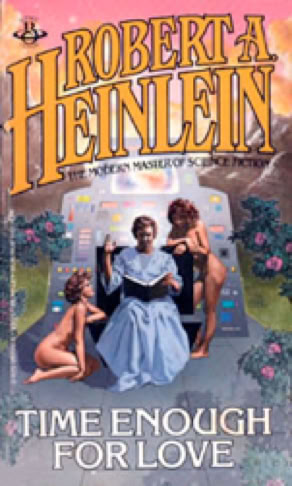
Time Enough for Love (1973 )
The book is about Lazarus Long , the universe's oldest living person, who is tired of living and wants to die. The book takes the form of several novellas tied together in the form of Lazarus's retrospective narrative . The Tale of an Adopted Daughter is a lengthy, western-style story about his days as a pioneer, which is rather un-SF fare for a book proclaimed as a SF classic. On the other hand, the pioneering does take place on another planet, and several genetically engineered animals — notably some talking, fertile mules — accompany Lazarus on his venture. One of the stories is about a US naval cadet who was "too lazy to fail". Another story is the high-tech colonization of a planet in the "modern" way. There is a bit of time travel at the end of the book. There are two "Intermission" sections, each some six or eight pages long, taking the form of lists of provocative phrases and aphorisms, possibly based on the author's views on Life, the Universe, and Everything. Some of these have become quite popular and can be found (amongst other places) in internet signatures to this day. This book is an outgrowth of the earlier Methuselah's Children and is connected to The Number of the Beast also by Robert A. Heinlein ,The Cat Who Walks Through Walls , and several other Heinlein novels. Finally, most of the events are told in first person from the point of view of the protagonist , Lazarus Long. Many are retold, also first person, from the point of view of his mother, Maureen Johnson Long, in To Sail Beyond the Sunset , the last novel Heinlein wrote and published before he died in 1988. This was, and still is, an uncommon approach to storytelling, and may be unique in fiction writing.

The Number of the Beast (1980 )
The Number of the Beast is a science fiction novel by Robert A. Heinlein published in 1980 (ISBN 0-44-913070-3 ). The book is a series of diary entries by each of the 4 main characters, Captain Zebadiah , programmer Deety and her math professor father, and an off-campus socialite. The odd foursome dash off in Zeb's sports car spaceship, outfitted with the professor's hyperspace drive, into various fictional universes. There is plenty of sex, rivalry, and even a trip to Oz . In the novel, the biblical number of the beast turns out to be, not 666, but , an unimaginably large, 36306-digit number (6??3 in Knuth's up-arrow notation ) which is the number of parallel universes accessible to the protagonists. The novel lies somewhere between parody and homage in its deliberate use of the style of the 1930's pulp novels . Many of the plot lines and characters are derived directly from the pulps, as directly referenced by the first line of the novel: "He's a Mad Scientist and I'm his Beautiful Daughter ." --Deety
Number of the Beast contains many in-jokes and references. For instance, the name of every villain is an anagram of a name or pen name of Robert or Virginia Heinlein . The book is generally held to be a contender for Heinlein's worst novel, although one school of thought holds that it is an extended demonstration of Heinlein's knowledge of writing using bad examples. In this book Heinlein introduced the concept called " pantheistic solipsism " or "world-as-myth" -- the theory that universes are created by the act of imagining them, so that somewhere even fictional worlds (Oz is one of the examples Heinlein uses) are real. Near the end, this book is connected to Time Enough for Love , and through it to several others of Heinlein's later works.

Friday (1982 )
Heinlein 's novel Friday was published in 1982 . This book tells the story of a female "artificial person" (a genetically-engineered person with enhanced physical and mental abilities) named Friday, set in the not-too-distant future. Friday is employed by a private intelligence agency as a courier, often carrying valuable information in a pouch in her belly. She differs anatomically in being much stronger and faster than other humans. Since artificial humans are widely resented, much of the story deals with Friday's attempts to win against prejudice, along with her attempts to conceal her gifts from other humans. This occurs against a backdrop of general social collapse that is intended to represent the irreversible decline of Western Civilization & the birth of an interstellar civilization.

Job: A Comedy of Justice (1984 )
The story examines religion through the eyes of Alex, a Christian political activist who is corrupted by Margrethe, a Danish cruise ship hostess — and loves every minute of it. Enduring a shipwreck, an earthquake , and a series of world-changes brought about by Loki (with Jehovah 's permission), Alex and Marga work their way from Mexico back to Kansas as dishwasher and waitress. On the way they enjoy the Texas hospitality of Satan himself, but as they near their destination they are separated by the Rapture —pagans don't go to heaven . Finding that eternity as depicted in the Revelation is far from the bliss he had so earnestly anticipated, Alex's journey through timeless space in search of his lost lady takes him to Hell and beyond. Heinlein's vivid depiction of a Heaven ruled by snotty angels and a Hell where everyone has a wonderful time — with Mary Magdalene shuttling breezily between both places — is a brilliant, biting satire on American evangelical Christianity.

The Cat Who Walks Through Walls (1985 )
The Cat Who Walks Through Walls is a science fiction novel by Robert A. Heinlein published in 1985 . It is one of the " Lazarus Long " set of books. A writer seated at the best restaurant on a space station is approached by a man who desperately but cryptically urges him that "Tolliver must die" — and is then himself shot before the writer's eyes. The writer — Colonel Colin Campbell, living under the alias (and nom de plume ) "Richard Ames" — is joined by a beautiful and sophisticated lady, Gwen Novak, who helps him flee with a bonsai and a would-be murdering bum to Luna. (Note that like the protagonist, Heinlein was a writer retired from the military with the initials R.A. and the initials G.N. remind us of his wife Virginia who was sometimes know as Ginny.) The Cat Who Walks Through Walls may be regarded as part of Heinlein's multiverse series, or as a sequel to both The Number of the Beast and The Moon is a Harsh Mistress . The title of the book refers to a cat by the name of Pixel, who has an inexplicable tendency to be wherever the narrator happened to be (see Schrödinger's cat ).
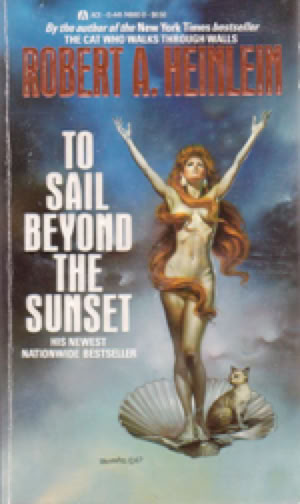

To Sail Beyond the Sunset (1987 )
To Sail Beyond the Sunset is a science fiction novel by Robert A. Heinlein published in 1987 . It was his last novel when he died in 1988; several books by the author were published posthumously, including a full novel; a collaborative novel is currently (Nov-04) being written by Spider Robinson as noted in more detail at the author page. It is one of the ' Lazarus Long ' set of books, involving time travel, parallel dimensions, free love, voluntary incest, and a concept that Heinlein named pantheistic solipsism - the theory that universes are created by the act of imagining them so that somewhere (for example) the Land of Oz is real. Its title is a line from the poem Ulysses , by Alfred Lord Tennyson . The complete sentence of which is a part is as follows: ... my purpose holds. To sail beyond the sunset, and the baths. Of all the western stars, until I die. Opinion is divided among science fiction fans as to whether this and other late Heinlein novels are brilliant, creative and original, or simply the wish-fulfillment of a man in his second childhood. At least one assertion has been made, in some detail and with references, that the book is intended as Heinlein's intentional grand joke poking fun at the entire genre of speculative fiction.
For Us, the Living by Robert Heinlein (2003)
In it, Perry Nelson, a normal 1939 engineer, is driving his automobile when he has a blowout, skids over a cliff, and wakes up after the car accident in the year 2086 . Though he apparently was killed in the summer he is saved from the freezing cold by a fur-clad woman named Diana (after the Roman goddess).
Written in 1937.
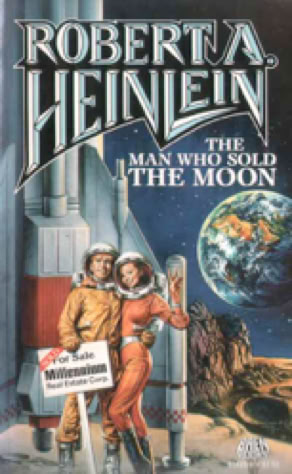
Collections
The Man Who Sold the Moon (1950 )
The Man Who Sold the Moon was the title of two anthologies of science fiction short stories by Robert A. Heinlein. The first one, published in 1953, included the stories " Life-Line ", "Let There Be Light", " The Roads Must Roll ", " Blowups Happen ", " The Man Who Sold the Moon ", and " Requiem ". The second anthology included only four of those stories, omitting "Life-Line" and "Blowups Happen." Both anthologies included a Heinlein timeline for his stories, characters, and events, and the first had an introduction by John W. Campbell, Jr.

Waldo and Magic, Inc. (1950)
Waldo & Magic, Inc. is a book containing those two science fiction short stories Waldo and Magic, Inc.

The Green Hills of Earth (1951 )
The Green Hills of Earth is an anthology of science fiction short stories by Robert A. Heinlein published in 1951. The title story is the tale of an old space mariner reflecting upon his planet of birth.

Orphans of the Sky (1963 )
Orphans of the Sky is a 1951 science fiction novella by Robert A. Heinlein , consisting of two parts: Universe and Common Sense. In the novella, a gigantic, cylindrical generation ship is cruising pilotless toward a distant solar system , inhabited by a crew that has forgotten their origins over time and lapsed into superstition. Most crew members lead a simple bucolic life of farming , never venturing to the upper decks where the "muties" ( mutants or mutineers ) dwell. One day, Hugh Hoyland starts exploring and finds the astonishing secret of the ship's purpose. This story refers to the sister ship of New Frontiers, the ship stolen by the Howard families in the story Methuselah's Children . This ship and the aftermath of this story are mentioned in passing in the novel Time Enough for Love .

Assignment in Eternity (1953 )
Assignment in Eternity is an collection of science fiction novellas by Robert A. Heinlein published in 1953. It contains Gulf, Elsewhen, Lost Legacy, and Jerry Was a Man

Revolt in 2100 (1953 )
Revolt in 2100 is a collection of a science fiction short novel and two short stories by Robert A. Heinlein . Part of Heinlein's Future History series, it was published in 1953. This first part, "If This Goes On—", describes a secularist rebellion against an American theocracy and thus served as the vehicle for Heinlein to critique the authoritarian nature of religious thinking and practice, Protestant Christian fundamentalism, and Mormonism. The other two parts, " Coventry " and " Misfit ", describe the succeeding secular liberal society from the point of view of characters who reject it

The Menace From Earth (1959)
(ISBN 0671578022 ) is a science fiction short story by Robert A. Heinlein. The Menace From Earth (ISBN 0552093345 ) is also a collection of Heinlein's short stories published in 1966, containing:
The Year of the Jackpot, By His Bootstraps, Columbus Was a Dope, The Menace from Earth, Sky Lift, Goldfish Bowl, Project Nightmare and Water is for Washing.

The Unpleasant Profession of Jonathan Hoag (1942 )
A man comes to an investigator with an odd request, he wants to have himself followed because he has no idea of his own profession. The story evolves into a discusion of the reality of both life and art.
Three by Heinlein (1965)
Three by Heinlein (1965) , Robert A. Heinlein , Doubleday , hc
The Robert Heinlein Omnibus (1958 )
The Omnibus is an anthology of science fiction short stories by Robert A. Heinlein which includes: The Man Who Sold the Moon, The Roads Must Roll, Logic of Empire, We Also Walk Dogs, Space Jockey, Requiem, Ordeal in Space, The Long Watch [vt Rebellion on the Moon ], Let There Be Light, It's Great to Be Back!, The Green Hills of Earth, Gentlemen, Be Seated!, Delilah and the Space-Rigger, The Black Pits of Luna, Without Doubt and "It Does Not Pay a Prophet to Be Too Specific"

The Worlds of Robert A. Heinlein (1966)
The Worlds of Robert A. Heinlein is a collection of science fiction short stories by Robert A. Heinlein published in 1966. It includes a introduction entitled Pandora's Box that describes some of the difficulties in making predictions about the near future. Heinlein outlines some of his predictions that he made in 1949 (published 1950 ) and examines how well they stood up to 15 years of progress in 1965 . These were originally published under the title Where to? (And Why We Didn't Get There?) . Following the introduction are five short stories: Free Men (first published in this collection, 1966 ), Blowups Happen (1940 ), Searchlight (1962 ), Life-Line (1939 ) and Solution Unsatisfactory (1940).

The Past Through Tomorrow
The Past Through Tomorrow was a collection of Robert Heinlein 's famed "Future History" stories. The stories, for the most part, follow the same storyline of a rapidly collapsing American sanity, followed by a theocratic dictatorship (If This Goes On...) and the development of true civilization and justice, which is squelched in the last story (Methelusah's Children), forcing the pseudo-immortal Howard Families to flee Earth for their lives from the approaching mobs. In the very end, the Howards (led by recurring Heinlein character Lazarus Long) return to find that the rest of the species has discovered the secret to immortality. The stories include: Misfit (1939), Life-Line (1939), The Roads Must Roll (1940)
Requiem (1940), If This Goes On... (1940), Coventry (1940), Blowups Happen (1940), Universe (1941), Methuselah's Children (1941), Logic of Empire (1941), Space Jockey (1947), It's Great to Be Back! (1947), The Green Hills of Earth (1947), Ordeal in Space (1948), The Long Watch (1948), Gentlemen, Be Seated (1948), The Black Pits of Luna (1948), Delilah and the Space Rigger (1949), and The Man Who Sold The Moon (1951 )
The Best of Robert A. Heinlein (1973)
The Best of Robert A. Heinlein (1973) , Robert A. Heinlein , Sidgwick
Expanded Universe (1980 )
This collection completely subsumes the 1966 collection titled THE WORLDS OF ROBERT A. HEINLEIN. A majority of the material, however, is new to this volume; a sizeable amount has never been reprinted since its first appearance. It holds a great deal of biographical material in the form of extended forewords and afterwords. Some of the more notable pieces included are "Blowups Happen", "Solution Unsatisfactory", "Free Men", "A Bathroom of Her Own", "Inside Intourist", "Spinoff", and "The Happy Days Ahead".
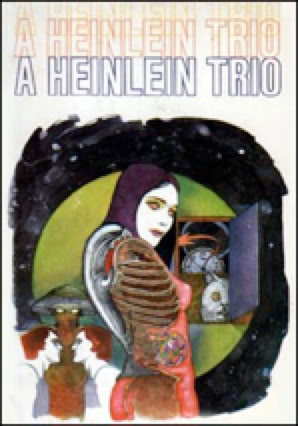
A Heinlein Trio (1980 )
The Puppet Masters, Double Star, and The Door Into Summer.
A Heinlein Trio (1980) , Robert A. Heinlein , SFBC , hc
A Heinlein Trio (1980) , Robert A. Heinlein , New York: Nelson Doubleday , hc, 502pp
The Fantasies of Robert A. Heinlein
The Fantasies of Robert A. Heinlein is a collection of short stories by Robert A. Heinlein , a science fiction author. The Fantasies of Robert A. Heinlein (1999) , Robert A. Heinlein , Tor

Non-Fiction
Grumbles from the Grave, Virginia Heinlein, ed. (1989)
Grumbles from the Grave contains an assortment of bits of writing by Robert Heinlein , edited by his wife Virginia Heinlein, published a year and a half after his death. It begins with a short biography of Robert by Virginia. The bulk of the book consists of excerpts of correspondence from the period from 1939 to 1970, from when he began writing science fiction until the onset of his first major illness. Additionally there is the original postlude to Podkayne of Mars and a discussion of cuts made to Red Planet . There is much detail here that will interest readers familiar with many of Heinlein's pieces and to people interested in the history of science fiction.

Tramp Royale (1993 )
Take Back Your Goverment (1992)
Nonfiction book; originally titled How to Be a Politician
Take Back Your Government!: A Practical Handbook for the Private Citizen Who Wants Democracy to Work was an early work by Robert A. Heinlein . It was published in 1992 after his death in 1988 . This book was written in 1946 but never found a publisher; perhaps due to excess candour. Like so many of Heinlein’s works, he wrote what he knew, in this case based on his experience in California politics in the 1930s and in particular his efforts on behalf of Upton Sinclair 's EPIC Movement and Sinclair's attempt to become the Democratic Party's nominee for California governor in 1934. The book contains hasty annotations by Jerry Pournelle , which he had no time to finish or polish or fact check, since the publication schedule was dictated by a need to have it hit the bookstands while the Ross Perot campaign for President of the United States was still going strong.